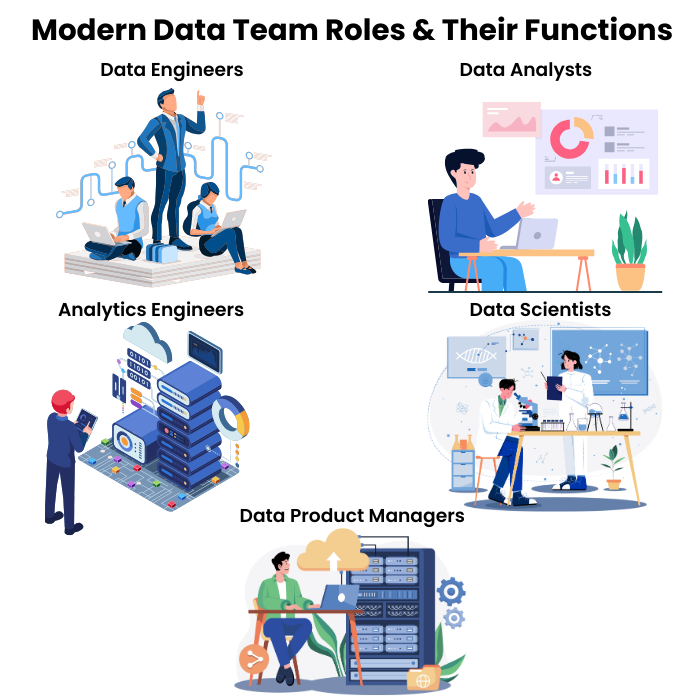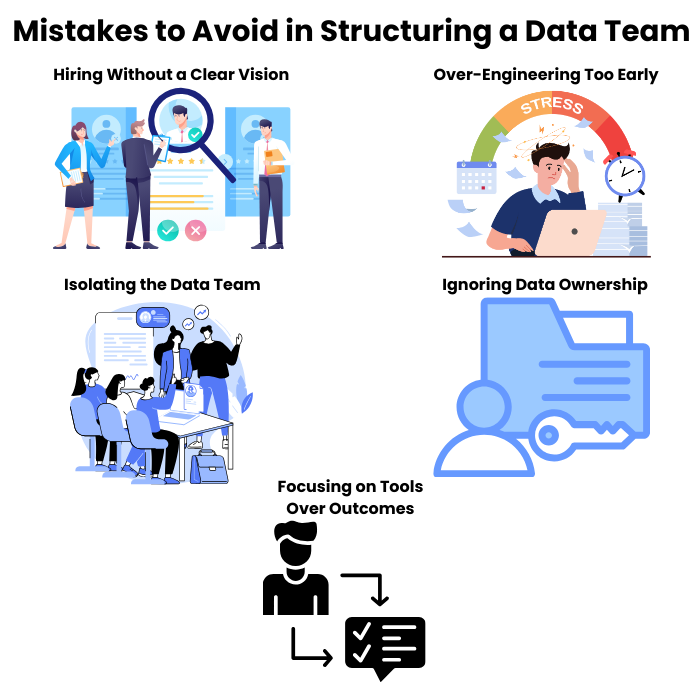Data is no longer a side function—it’s the backbone of decision-making in every fast-moving company. But as data grows, so does the need for smarter teams to manage it. Old team models—where one analyst ran reports—can’t keep up.
Modern data teams do more than crunch numbers. They build internal tools, shape business strategy, and work hand-in-hand with product, marketing, and engineering. Their structure, not just their skills, makes or breaks their impact.
So read on—we’re breaking down what a high-performing data team looks like today. You’ll see which roles matter, how to structure them, and what to avoid as you scale.
What Makes a Modern Data Team Different?
Old-school data teams were built for support. They pulled reports, built dashboards, and answered business questions after the fact. Their job was to react.
Modern data teams flip that model. Instead of waiting for requests, they help shape the questions and build the systems that deliver answers at scale. They work more like internal product teams—creating tools, pipelines, and models that power real-time decisions and keep the business moving.
Another key shift? Collaboration. Today’s data teams don’t work in a bubble. They’re embedded across the company, partnering with product, marketing, ops, and engineering. This isn’t just about better communication—it’s about speed, context, and impact. When data people are part of the conversation early, they solve the right problems faster.
So read on—because understanding this shift is the first step to building a team that actually drives business outcomes.
Core Roles in a Modern Data Team (and What They Do)

A modern data team isn’t just a group of people with “data” in their titles. It’s a mix of specialized roles working together to turn raw information into real business outcomes. Here’s what each one brings to the table—and why it matters.
1. Data Engineers
Data engineers are the builders behind the scenes. They create and maintain the pipelines that move data from sources like apps, APIs, or logs into warehouses where others can use it. Without them, there’s no reliable data—just noise.
They handle extract-transform-load (ETL) processes, cloud infrastructure (AWS, GCP, Azure), and scheduling tools like Airflow or Prefect.
But the real value? They make sure data is available, fast, and trustworthy—so analytics doesn’t grind to a halt during a launch or decision sprint.
Who they work with: Platform engineers, analytics engineers, and anyone who needs consistent, production-ready data.
2. Analytics Engineers
Think of them as the translators between raw data and business-ready insights. They build and maintain the “semantic layer”—clean, well-documented tables that feed into dashboards and reports.
Using tools like dbt, they shape messy data into trusted sources others can explore.
Their work avoids “dashboard sprawl” and makes sure different teams aren’t working from different numbers.
Why they matter: Without analytics engineers, you get broken dashboards, duplicated logic, and confused decisions. With them, you get clarity and confidence in every metric.
3. Data Analysts
Analysts are the eyes of the business. They explore patterns, dig into trends, and help teams understand what’s happening—and why. Their insights fuel campaigns, experiments, forecasts, and roadmap decisions.
They use SQL, Excel, and BI tools like Looker or Tableau to build dashboards and answer ad hoc questions fast.
But the best analysts don’t just report—they challenge assumptions, ask smarter questions, and bring stories to the data.
Where they shine: Supporting product teams, marketing, ops, finance—anywhere decisions are being made.
4. Data Scientists
While analysts explain the past, data scientists predict what’s next. They run experiments, build machine learning models, and optimize everything from product features to customer lifetime value. As data scientists evolve in their roles, many find themselves transitioning to product management, where their analytical skills become invaluable in shaping product strategy. By leveraging insights drawn from data, they can influence key decisions and prioritize features that enhance user experience. This synergy between data and product development leads to innovative solutions that better meet customer needs.
Their models are used for recommendations, risk scoring, demand forecasting, and more.
But here’s the catch: technical skills alone aren’t enough. Without domain context, even the best models can miss the mark. That’s why the strongest data scientists work closely with stakeholders, not in silos.
Toolset: Python, R, Jupyter, scikit-learn, Spark, plus a solid grasp of experimentation and causal inference.
5. Data Product Managers
Data PMs keep the team pointed in the right direction. They translate business needs into roadmaps, prioritize what gets built, and make sure the team’s work leads to real results, not just cool charts.
They understand data but aren’t necessarily writing code. Instead, they align stakeholders, set expectations, and balance short-term requests with long-term infrastructure work.
What makes them valuable: They prevent chaos, scope work with impact in mind, and help the team say “no” to distractions—so data work moves the needle.
Optional & Emerging Roles
These roles aren’t always part of the early data team, but as companies grow, they become key players in keeping things fast, safe, and scalable.
- Machine Learning Engineers
They bridge the gap between data science and software engineering. While data scientists build models, ML engineers turn those models into reliable, production-ready systems. They handle versioning, deployment, monitoring, and scaling, making sure the model works not just in theory, but in the real world.
- Data Governance Leads
As data volume grows, so does the risk of bad data or compliance issues. Governance leads create rules and systems that protect data quality and privacy. They manage access, ensure legal compliance (like GDPR or HIPAA), and track where data comes from and how it’s used. Without them, trust in data breaks down fast.
- Data Platform Engineers
These engineers build the internal tools that power the data team. Think dev tools, CI/CD for data, and self-serve analytics platforms. They don’t just keep the stack running—they make it easier for analysts, scientists, and engineers to do great work without constantly reinventing the wheel. By leveraging their expertise in full stack development fundamentals, these engineers ensure that every aspect of the data infrastructure is robust and efficient. They also prioritize user experience, creating intuitive interfaces that empower team members to maximize their productivity. Ultimately, their work enhances collaboration across the organization, driving impactful insights and informed decision-making.
How to Choose the Right Team Structure for Your Company
There’s no perfect data team setup—just the one that fits where your company is right now. The right structure depends on your size, stage, and how deeply data is used across teams. Let me break down your main options and when it’s time to switch things up.
Centralized vs. Decentralized vs. Hub-and-Spoke
Centralized teams keep all data work in one place. Everyone reports to the same manager, and all requests come through a single pipeline.
- Pros: Easy to manage, consistent tooling, better data quality.
- Cons: Slower response times, teams may feel disconnected from the data work being done for them.
Decentralized teams embed data people inside departments like product, marketing, or sales.
- Pros: More context, faster insights, tighter alignment.
- Cons: Inconsistent tools, duplicated work, weaker shared standards.
Hub-and-Spoke blends both. Core data roles (engineers, governance) stay centralized, while analysts or analytics engineers are embedded with other teams.
- Pros: Balance of speed and consistency.
- Cons: Requires stronger coordination and clear ownership rules.
So read on—because structure matters more as your team grows. What works for 5 people won’t work for 20.
When to Transition Structures
You know it’s time to rethink your setup when bottlenecks pile up or teams start working around the data group instead of with it. Here are a few red flags:
- Too many one-off requests clog the pipeline
- Business teams building their shadow analytics
- Engineers or analysts constantly context-switching
- No clear owners for key metrics or tools
Ask yourself:
- Who owns what?
- Can business teams get answers quickly?
- Are we building systems—or just reacting?
If the answers aren’t clear, it’s time to evolve your team.
How Do Different Types of Data Engineers Contribute to Modern Data Team Structures?
In modern data team structures, each professional plays a vital role. From data architects who design systems to data analysts who interpret insights, these diverse skills enhance collaboration. Understanding how these contributions interlink is key, making the topic of data engineering roles explained essential for organizations looking to optimize their data strategies. An effective data strategy is built upon a foundation of clearly defined responsibilities and expertise. To achieve the best outcomes, organizations must understand the ideal data engineering team roles that bring together technical proficiency and analytical thinking. This ensures that data pipelines are not only efficiently managed but also aligned with the broader business objectives, fostering a culture of data-driven decision-making.
Building a Scalable Data Team: Best Practices
Hiring great people is only the start. If you want a data team that scales, you need smart systems, clear priorities, and shared habits that keep everything moving, even as headcount and workload grow.
- Hire for range first, specialization later.
In the early days, you need people who can wear multiple hats—engineers who can model data, analysts who can write SQL and tell a story. As the team grows, roles can narrow, but early hires should be flexible and business-minded. These early team members not only contribute their technical skills but also foster a culture of adaptability and innovation. By cultivating an environment where knowledge sharing is encouraged, they can provide valuable engineering career growth insights that help each individual develop their skill set. This collaborative spirit ensures that as the company evolves, the team remains aligned with business objectives while driving personal and collective success.
- Build with documentation from day one.
Scaling isn’t about adding people—it’s about helping them move faster. Clean documentation saves hours, avoids repeated mistakes, and makes onboarding easier. Treat it like code: keep it versioned, reviewed, and useful.
- Encourage self-service, not more requests.
Teach business users to fish. Build dashboards, data dictionaries, and clean tables that they can use without waiting for help. This frees your team to focus on deeper work while still driving value.
- Work closely with engineering.
Don’t let the data stack drift into its world. Stay connected with platform teams so your pipelines are stable, monitored, and secure. It’s easier to prevent a fire than to fix a burned-out system.
- Avoid tool overload.
You don’t need a dozen platforms to be data-driven. Pick tools that fit your team’s size and skill level. What matters more is how you use them, not how many logos are on your stack.
- Focus on culture, not control.
Great data teams don’t grow from strict rules—they grow from shared habits. Weekly demos, clear ownership, and open feedback loops build trust. The goal is speed with quality, not bureaucracy.
Common Mistakes to Avoid in Structuring a Data Team

Even smart teams hit walls—and most of the time, it’s not a skills problem. It’s how the team was set up. Here’s where things usually go sideways, and how to avoid the same traps.
1. Hiring Without a Clear Vision
Stacking your team with data talent before you’ve defined goals leads to confusion and wasted time. It’s easy to get excited by fancy resumes, but without a clear plan—who owns what, what success looks like—you’ll end up with mismatched roles and scattered priorities. Build the mission first, then the team.
2. Isolating the Data Team
When data sits on the sidelines, it gets ignored—or worse, misused. Teams that operate as ticket-takers, disconnected from day-to-day work, lose trust fast. Embedding data people into product, marketing, or ops ensures they get context, solve real problems, and stay aligned. Skip the helpdesk model—it slows everything down.
3. Over-Engineering Too Early
Don’t build like you’re Google when you’re still figuring out your first use cases. Too many teams invest in heavy architecture before validating what people need. The result? Fancy pipelines nobody uses. Start with quick wins, prove value, and let the tech grow with the demand, not ahead of it. Focus on understanding your users and iterating based on their feedback. The foundation of any successful project lies in building effective engineering teams that prioritize collaboration and adaptability. By fostering a culture of experimentation, you ensure that your solutions evolve alongside user needs, paving the way for sustainable growth.
4. Ignoring Data Ownership
No one owns the data, everyone assumes someone else does, and suddenly… nothing gets done. Every key table, dashboard, and model should have a name next to it. Without clear ownership, errors go unnoticed, requests stall, and trust fades. Good teams don’t just build—they maintain.
5. Focusing on Tools Over Outcomes
It’s tempting to chase the latest platforms or rebuild dashboards every quarter. But tools don’t solve problems—people do. Focus on delivering answers, not managing software. A basic dashboard with the right insight beats a fancy setup that nobody checks.
Conclusion
Modern data teams aren’t built overnight. They’re shaped by the roles you hire, the structure you choose, and the systems you build to support them. The companies that get it right don’t just collect data—they turn it into a competitive edge.
Whether you’re just starting or scaling fast, remember this: a high-performing data team needs clarity, connection, and context. Hire with intent. Embed with purpose. Build for real use, not for show.
Now’s the time to take a step back, look at your team, and ask: Are we set up to drive impact—or just chasing requests?
The structure is the strategy. Build wisely—and your data team won’t just keep up, it’ll lead the way.

